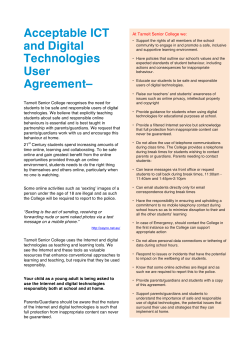
1.1 Patterns and Inductive Reasoning Goal Standards reasoning.
Untitled.notebook February 01, 2008 1.1 Patterns and Inductive Reasoning Goal: Find and describe patterns and use inductive reasoning. Standards: 1.0 Students demonstrate understanding by identifying and giving examples of undefined terms, axioms, theorems, and inductive and deductive reasoning. 3.0 Students construct and judge the validity of a logical argument and give counterexamples to disprove a statement. Untitled.notebook February 01, 2008 A conjecture is an unproven statement that is based on observations. Inductive reasoning is a process that involves looking for patterns and making conjectures. A counterexample is an example that shows a conjecture is false. Untitled.notebook February 01, 2008 Example 1 Describing a Visual Pattern Sketch the next figure in the pattern. 1st. term ➦ CW 2nd. term Next term 3rd. term ➦ ➦ ➦ Each figure looks like the one before it except that it has rotated 90°. The next figure will have the smaller circle in the lower-left quarter of the bigger circle. Untitled.notebook February 01, 2008 1. Sketch the next figure in the pattern. 1st. term 2nd. term 3rd. term Next term Untitled.notebook February 01, 2008 Example 2 Describing a Number Pattern Describe a pattern in the sequence of numbers. Predict the next number. a. 5, 3, 1, -1, ....____ These are consecutive odd numbers, but listed backwards starting with 5. The next number is -3. b. 1, -4, 9, -16,... ____ These numbers look like consecutive perfect squares, except that every other is negative. The next number is 25. Untitled.notebook February 01, 2008 Example 2 Describing a Number Pattern Describe a pattern in the sequence of numbers. Predict the next number. c. 1 2 , 1 4 , 1 8 , ....____ Each number is 1 2 times the previous number. The next number is 1 16 . Untitled.notebook February 01, 2008 Describe a pattern in the sequence of numbers. Predict the next number. 2. 1, 2, 6, 24, ____ Untitled.notebook February 01, 2008 Describe a pattern in the sequence of numbers. Predict the next number. 3. 0, 3, 8, 15, 24, ____ Untitled.notebook February 01, 2008 Example 3 Making a Conjecture Complete the conjecture. Conjecture: The product of two consecutive even integers is divisible by ______________ List some specific examples and look for a pattern. 2(4) = 8 = 8(1) 4(6) = 24 = 8(3) 6(8) = 48 = 8(6) 8(10) = 80 = 8(10) 10(12) = 120 = 8(15) 12(14) = 168 = 8(21) Conjecture: The product of two consecutive even integers is divisible by 8 Untitled.notebook February 01, 2008 4. Complete the conjecture based on the pattern you observe in the specific cases. Conjecture: For any two numbers a and b, the product of (a + b) and (a - b) is always equal to _____________________ (a + b)(a - b) = a2 - b2 2 2 (2 + 1)(2 - 1) = 3 = 2 - 1 (3 + 2)(3 - 2) = 5 = 32 - 22 (4 + 3)(4 - 3) = 7 = 42 - 32 2 2 (5 + 4)(5 - 4) = 9 = 5 - 4 Untitled.notebook February 01, 2008 Example 4 Finding a Counterexample Show the conjecture is false by finding a counterexample. Conjecture: All odd numbers are prime. The conjecture is false. Here is a counterexample: The number 9 is odd and is a composite number, not a prime number. Untitled.notebook February 01, 2008 Show the conjecture is false by finding a counterexample. 5. The square if the sum of two numbers is equal to the sum of the squares of the two numbers. that is, (a + b)2 = a2 + b2
© Copyright 2025





















